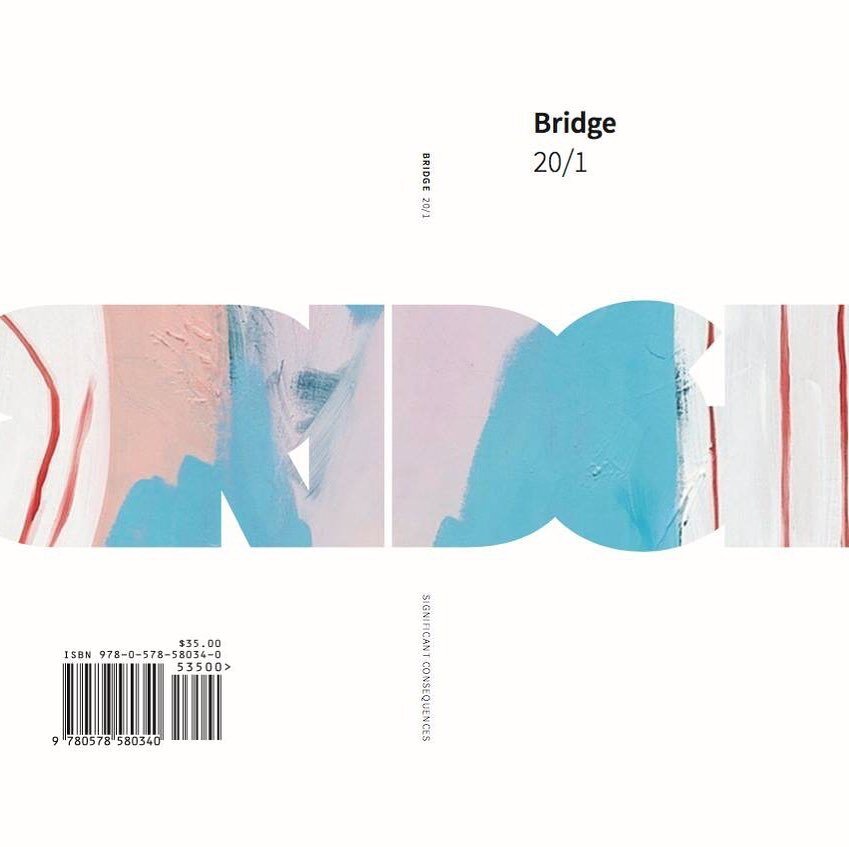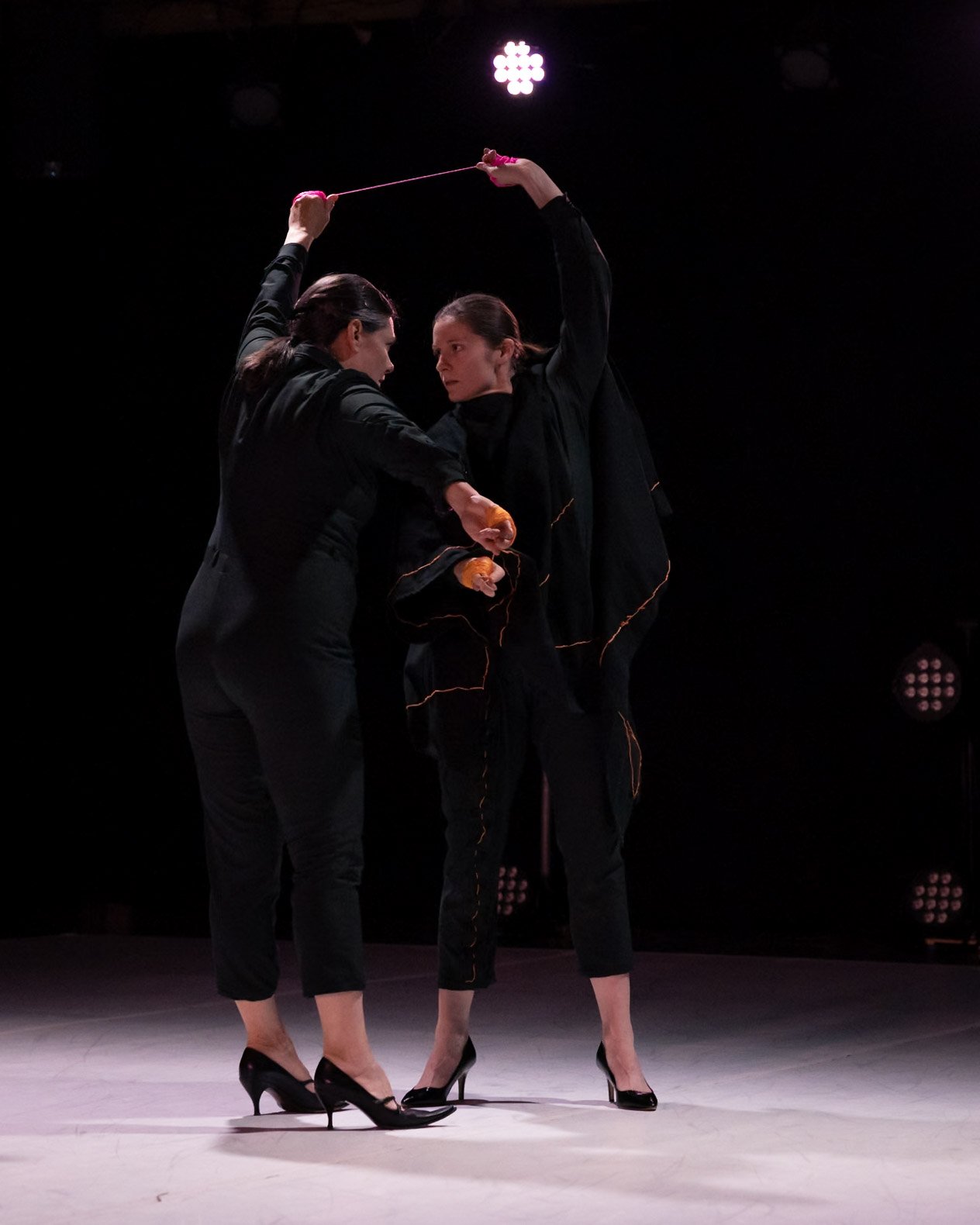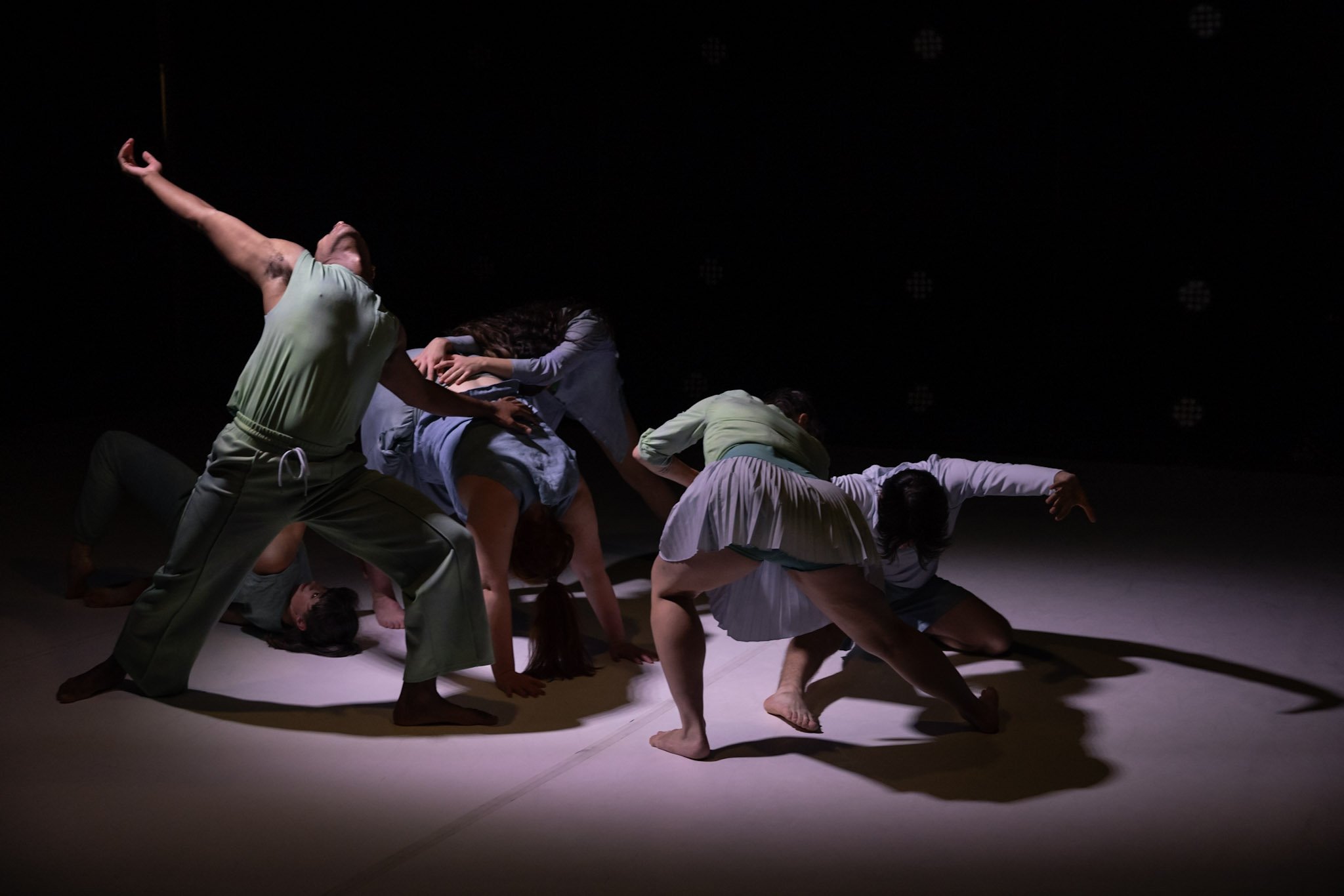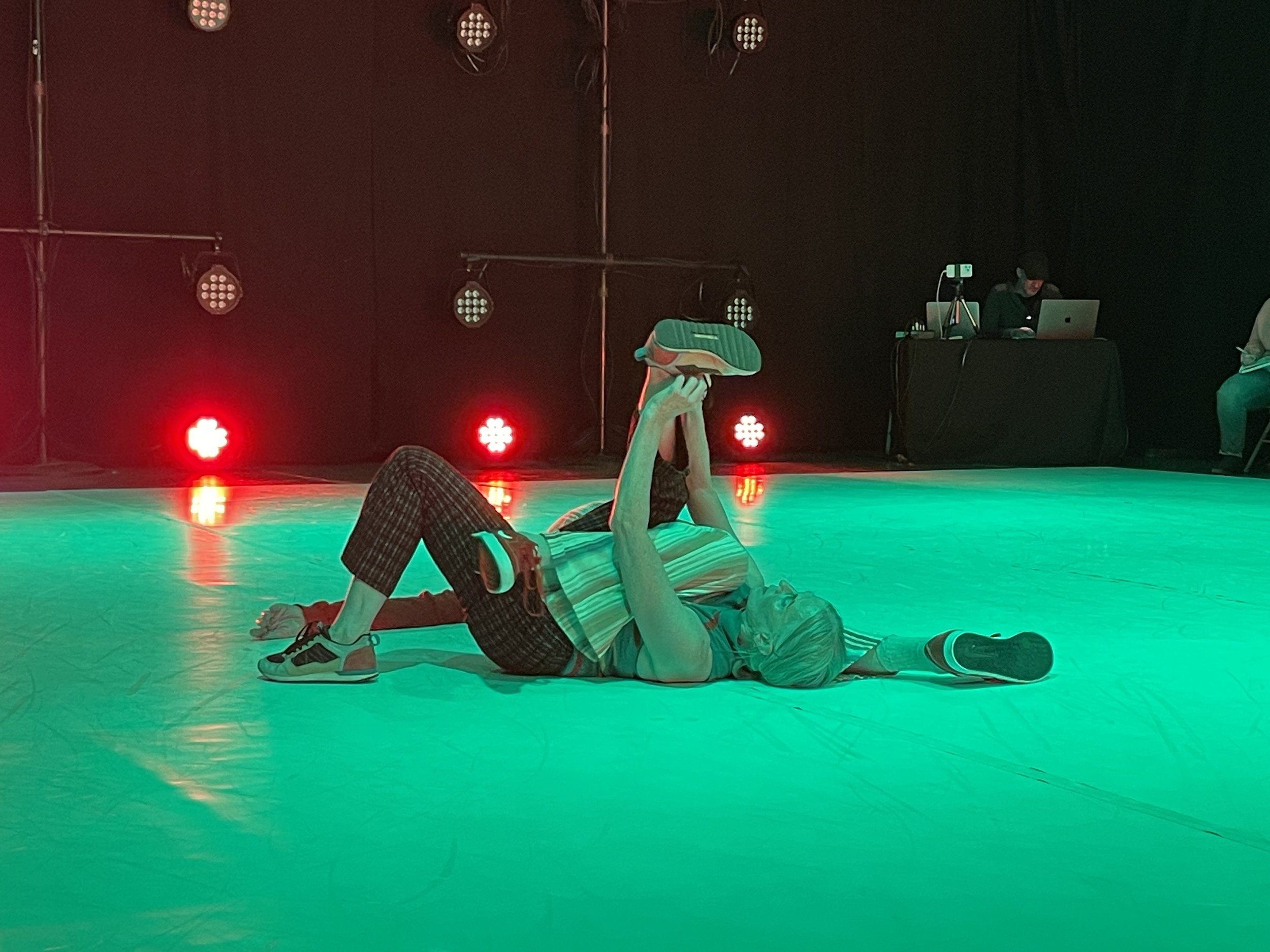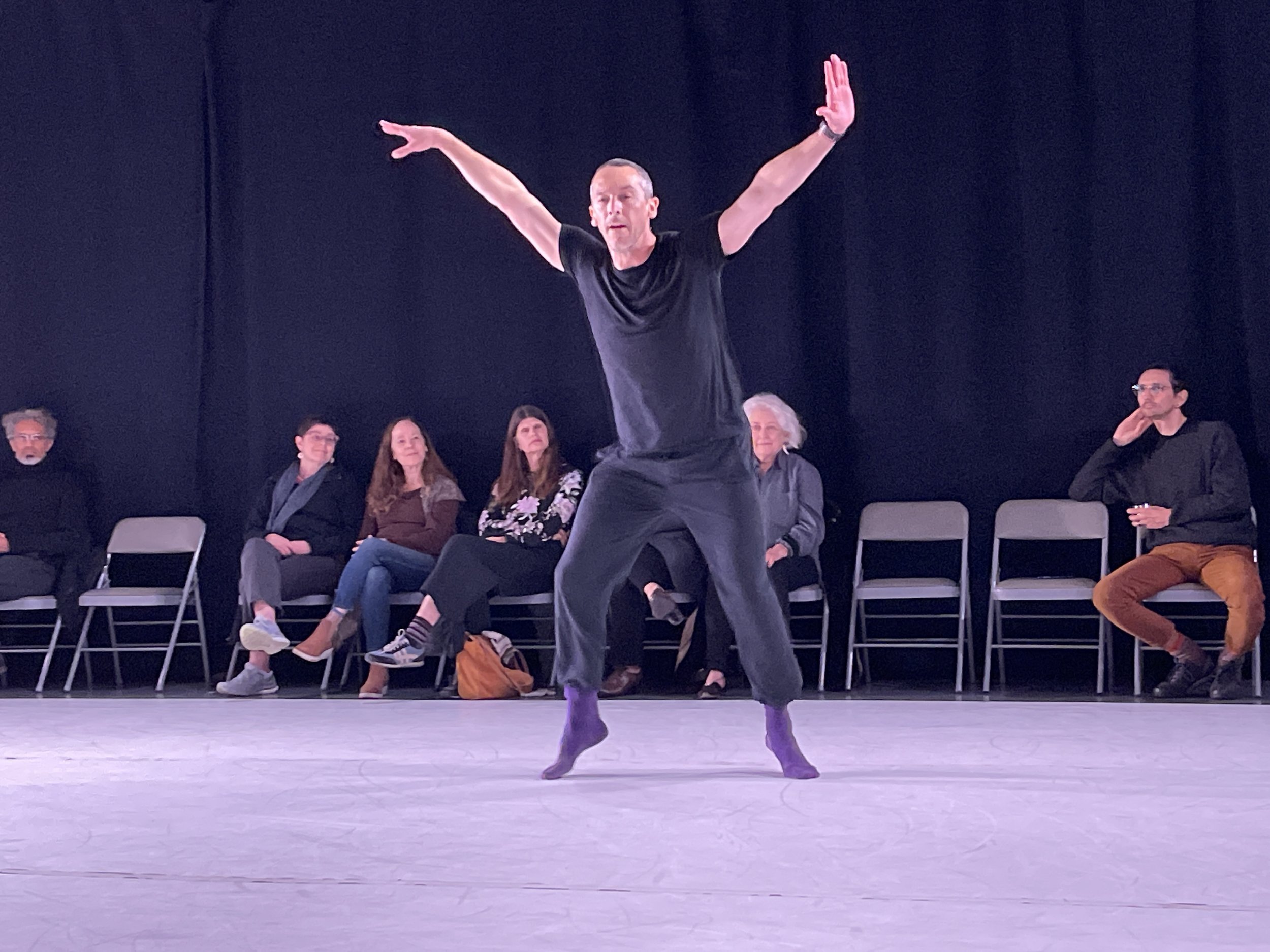REVIEW: “3320 Dance Series” at the Dovetail Performance Garage
Michelle Kranicke and Molly Strom performing “Shadows Across Our Eyes.” Image courtesy Dovetail Dance Studios and the artists.
REVIEW
3320 Dance Series
The Garage at Dovetail Dance Studios
2853 W. Montrose Ave.
Chicago IL 60618
Oct 25—Nov 3, 2024 (run completed)
By Michael Workman
THE 3320 DANCE SERIES IS A NEW TWO-WEEKEND MINI-FESTIVAL held in the transformed garage space at Dovetail Studios—a large studio in the front of the building reimagined as a black box theater with ample pipe and drape. Lit by large LED lights mounted on tripods to the front and back, the visuals and audio were masterfully managed by A/V technician Richard Norwood. Each weekend of performances feels like an attempt at some kind of deep reconsolidation of the dance and performance art scene in general in Chicago, which in recent months has been rocked with largely (and inexplicably, even criminally) unreported closings and turmoil. The Chicago Moving Company recently announced they would cease operations at Hamlin Park, for example, where it has been an Arts-Partner-in-Residence since 2001. Links Hall, a Chicago dance and performance institution, recently announced Lifeline for Links, a desperate attempt to rally community contributions to the tune of $350,000 in six weeks simply to continue operating.
While these cuts are happening in the arts generally (don’t get me started on the literary arts, which seems to always come in last for funding, even as book bans advance across the nation) dance has been particularly hit hard—and there’s no end in sight. Many programs were outright cut, for example, at Columbia College Chicago, which recently did away with programs one would think of as essential to an art school—including Art History, alongside celebrated beacon programs such as Creative Writing and the only ASL certificate program in the country. Among the list of other programs under consideration for the chopping block, the dance program has been mentioned as among potentially among the next to go—regardless that the Dance Center is widely perceived as among the best in the city, if not the Midwest.
There is a long-recognized degree of tribalism to the Chicago art and dance scenes, which for some time now has been viciously (and ill-advisedly) siloed and subdivided even more deeply by special interest advocates policing the boundaries and admitting only those carrying the correct calling card. Where people used to go to see great art, too often now the deciding factor is whether someone you know is involved. This type of strategic essentialist approach can indeed generate short-terms gains, but it’s not at all how the wider dance-presenting world works and is a recipe for long-term organizational vulnerability and risk exposure; hello insularity and exclusion, goodbye general audiences.
Michelle Kranicke and Molly Strom performing “Shadows Across Our Eyes.” Image courtesy Dovetail Dance Studios. Video by Michael Workman.
Such is the context into which Dovetail has mounted this new mini-fest. Zephyr, an experimental dance company dedicated to challenging current trends in dance, who this year gave up its own Arts-Partner-in-Residence space at Holstein Park, where it had hosted dance classes and presented performance works since 1996. Known for its critical investigations into the overreliance on virtuosity, pushing back against popular definitions, and the frequent use of narrative to frame abstract movement, Zephyr also champions the aging performative body. Highlighting the unique strengths of mature artists, the company places these performers alongside younger dancers, often yielding a rich dialogue between generations of practitioners. Through its curatorial program at SITE/less, Zephyr’s performing home that the company launched in 2018, it also supports alternate perspectives in dance, providing platforms for new voices and emerging practices.
In this 45-minute performance, as is often the case, it feels like a lot is on the line as Kranicke enters the space unspooling an orange line of yarn across the floor to a traditional score by Ennio Morricone, an opening sequence in which she reprises and reimagines moments from Shadows Across Our Eyes, a piece first performed at SITE/less in 2018. She stretches the line across the dance floor to the opposite corner, where a hand emerges from behind a curtain, wrapped in the same orange yarn. Molly Strom enters shortly after, clad in a cape, with both performers dressed in black (both costumes designed by Amanda Lee Franck)—Kranicke’s outfit marked by pink “X” stitches. Moving in a choreographed circle, the two are tethered by the yarn, creating an evolving pattern of orange and pink.
As the music crescendos, they retreat to opposite corners, each dancer holding one hand wrapped in yarn—Kranicke in orange, Strom in pink. They then begin drawing in their lines, removing their shoes one by one, bowing their heads, and reaching out with open hands, beckoning each other closer. As they approach, their foreheads touch, and the soundtrack shifts to static and distorted audio. They stomp in rhythm, mouths open in silent screams, building tension. Kranicke begins to unravel the pink stitching on her costume while Strom puts her shoes back on. Kranicke, now undone, reveals a white short-sleeved shirt beneath her black costume. Strom exits, leaving a loose end of yarn, which Kranicke uses to guide her exit beyond the curtain, leaving her shoes behind.
Above: Scenes from “Shadows Across Our Eyes.” Images courtesy Dovetail Dance Studios and the artists.
Next in the lineup is Joseph Ravens, founder and director of the now-defunct Defibrillator Gallery and Rapid Pulse International Performance Art Festival (which held its final iteration in 2017), and a sometimes faculty member in the Performance Department at the School of the Art Institute. Ravens begins his approximately 10-minute solo performance, Hindsight, wrapped head-to-toe in fabric resembling the entry curtain, save for one stiff arm held aloft, topped with a blue plastic glove. He slowly unravels this wrap, revealing his costume: an oversized white oxford shirt, a black skirt, and a red-striped sock on one foot, the other foot bare. As he sheds the fabric, Ravens slips his arms inside the oversized shirt, rummaging downward to his skirt—a sweatshirt—and raises it slowly, stripping off the white oxford entirely.
Above: Scenes from “Hindsight.” Images courtesy Dovetail Dance Studios and the artist.
A small, remote-controlled car with another blue plastic glove mounted on top wheels loudly into the space. After maneuvering it around the room, Ravens removes the glove, revealing a large, metallic blue butt plug attached to the car. He places the glove on his left foot, pulls the black sweatshirt over his head, revealing his nude body with genitals tucked and a black felt void covering his abdomen. For several minutes, he digs at the void, as though trying to excavate his viscera, eventually ejecting a small, bright red rock-like object from his mouth. It lands softly, and he briefly contemplates it before abruptly exiting the space.
Joseph Ravens performing “Hindsight.” Courtesy Dovetail Dance Studios. Video by Michael Workman.
For the final performance of the first weekend, Dovetail owner and Same Planet Performance Project, a performing and dance-making organization in Chicago for over 25 years directed by Dovetail founder Joanna Read presented FLAK. A new work performed by an ensemble of six dancers: Chloe Michels, Sam Crouch, Kathryn Hetrick, Patrick Burns, Juli Farley, and Sydney Osborne, the large ensemble stood out from the sheer number of dancers onstage. Four different musicians score the performance as well, with contributions from Chaya Czernowin, Marco Momi, Tsippi Fleischer and Kenneth Hesketh. Entering in darkness to the sounds of a loud trumpet and piano, the dancers spread throughout the space as lights gradually rise, each dressed in soft pastels of pink, green, and light blue. The ensemble remains offstage while Burns and Michels begin the piece, holding hands as the music takes on a mechanical rhythm, with the group gradually joining in synchronized movement that spreads and contracts throughout the space like a growing, churning engine of human movement.
Above: Scenes from “FLAK.” Images courtesy Dovetail Dance Studios and the artists.
Each dancer explores individual movement combinations, forming duo and group formations—a few lean against each other like fatigued boxers, while others form circles as lighting shifts from red to blue to yellow, synchronized with vocal choruses that mirror the group’s movements. Everyone clearly gave every movement their all, but Farley is thrilling in her own solo section, and Hetrick’s exhaustive deep dive left her dripping sweat, hair blown out into a windswept mane, and audience members blown away. In that climactic final sequence, Burns and Hetrick partner for an intense, physically unbridled duet, moving from stomping to throwing one another across the space, before tumbling to the floor in near-convulsions, then stumbling back to their feet, throwing their arms in all directions in a crescendo of energy until, finally, the room plunges into darkness.
Scenes from “FLAK.” Images courtesy Dovetail Dance Studios and the artists. Videography by Michael Workman.
FOR THE SECOND WEEKEND of the mini-fest, Bob Eisen and Joanne Barrett’s performance of 33 Years Later begins with a bedside lamp illuminating a corner of the space, soon followed by a small radio turning on, blaring crackling sound design by Liz Flood (and Lia Kohl on Saturday). As the lights rise, Eisen and Barrett enter, approach the radio, then embrace one another—a gesture that initiates their exploration of the space. Eisen, a co-founder of the Links Hall (mentioned above), has been a pioneering force in experimental and improvisational dance in Chicago since 1978. Now living in New York, his deeply intuitive movement and dedication to play have helped shape Chicago’s contemporary dance scene, with his work resonating both nationally and internationally.
In this performance, Eisen and Barrett move around the space, waving their arms, throwing playful kicks, and experimenting with formations that reflect their own intuitive movement styles. They echo each other’s gestures, making occasional physical contact, and, in separate iterations, roll together to the floor. At one point, Barrett kicks off one shoe, then the other, as the lights progress through an intense palate of red then blue, green to aquamarine. Eisen glides effortlessly through the radiances, his imposing frame anchoring the garage space while Barrett’s movements bring her in closer contact with the seated audience, creating a sense of intimacy and spontaneity. Together, they embody the legacy of innovation that Eisen has contributed to the Chicago dance community, blending improvisation with a unique collaborative spirit.
Above: Scenes from “33 Years Later.” Images courtesy Dovetail Dance Studios and the artists.
Eisen’s movements are both effortless and grounding, as he wobbles around the space with a relaxed presence. Barrett eventually wraps herself around his neck and shoulders, playfully bouncing her stomach against his backside, followed by a climactic moment as she leaps up onto his frame, clinging upside down like a baby sloth. Eisen, audibly struggling, carries her across the dance floor until she leaps down and guides him around with a hand on his back, moving them together around the corner, until they eventually they’re facing each other again. The radio’s volume rises and falls, adding layers of intimacy to their interaction. Barrett retreats to a corner, retrieving her shoes, while Eisen lowers himself again to the floor, seemingly resisting her approach as she uses her foot to manipulate his long limbs into playful configurations. She then lays atop his frame, becoming the “little spoon” to his “big spoon,” resting there until Eisen slowly rolls away. As the lights intensify, he picks up her shoes, which she promptly takes back, slipping them on before one last turn around the dance floor. Eisen follows, and the lights once again fade to black.
Scenes from “33 Years Later.” Images courtesy Dovetail Dance Studios and the artists. Videography by Michael Workman.
Following Eisen and Barrett, Chicago native Terence Marling presents Ham and Cheese, with an opening sequence set to Edith Piaf’s Non, Je Ne Regrette Rien. Marling began his training under Larry Long at the Ruth Page Foundation School of Dance before nine seasons as a soloist with the Pittsburgh Ballet Theater, where he performed in major classical ballets and works by contemporary choreographers. Afterward, Marling joined the Nationaltheater Mannheim Ballet in Germany, contributing to the creation of eight evening-length works before, in 2005, returning to Chicago to join Hubbard Street, performing for four seasons before becoming Rehearsal Director in 2010 and then Director of Hubbard Street 2 in 2013. In 2017, he transitioned to freelance work, and has taught at various institutions, choreographed new works, and restaged existing pieces. From 2019 to 2023, he directed COMMON Conservatory, a laboratory for new choreographic works and a training program for pre-professional dancers.
He slides effortlessly across the space in purple socks, showcasing a captivating repertoire of circling limbs and sustained poses. As the lights dim, he turns his attention to an audience member spotlighted across the room, drawing closer and pointing at her as she stares back. Suddenly, a loud, crying baby noise pierces the space, and Marling breaks off to “comfort” the imagined infant across the dance floor.
This brief interlude shifts into I Put a Spell on You by Screamin’ Jay Hawkins, prompting Marling into an energetic floor routine with dynamic arm movements, leg slaps, and pinwheeling limbs. He lays flat and performs a full-body wave, impressively kicking up from the floor to his feet before diving into precise hand choreography. A voiceover begins, describing “mommy wrist”—a condition related to repetitive strain from everyday activities. Marling mimes domestic chores, like washing dishes, to highlight how these daily movements contribute to the injury. I was captivated by this introspective section and wished to see more.
Scene from “Ham and Cheese.” Video courtesy Dovetail Dance Studios and the artist. Photo by Michael Workman.
Near the end of the performance, Marling then returns to a lighthearted sequence set to Fly Me to the Moon by Frank Sinatra. He incorporates more hand movements into his routine, alternating between high leaps and deep, expressive kicks. The performance remains highly kinetic throughout, leading to an intense and dynamic finale just as the stage goes dark. Following Marling’s work, Small Planet’s presents an encore performance of FLAK from the first weekend.
In the end, while many other dance and performance art organizations are closing up shop, losing their performance spaces across the city or asking for a lifeline, Dovetail and the presenters of the 3320 Dance Series are throwing dance-loving audiences one instead. As dance in Chicago teeters on the edge of a kind of cultural recession that threatens to reduce a previously robust experimental and new avant-garde scene to backwater status—brought on by equal pie-slice combinations of shifts in funder priorities, the ripple effects of the pandemic, straight up mismanagement, donor fatigue and reductions in disposable income brought on by spiking inflation (among many other factors)—having at least one place where people can go who are simply interested in the art forms—and not just what their circle of friends is putting on—is crucial. Hopefully, this performance can serve as a reminder and a fresh cornerstone upon which to catalyze and rebuild a dance scene that has forgotten what it does best—make great art for general audiences who crave it.
Michael Workman is the Editor-in-Chief of Bridge. More info at Michael Workman Studio.
Like what you’re reading? Consider donating a few dollars to our writer’s fund and help us keep publishing every Monday.

